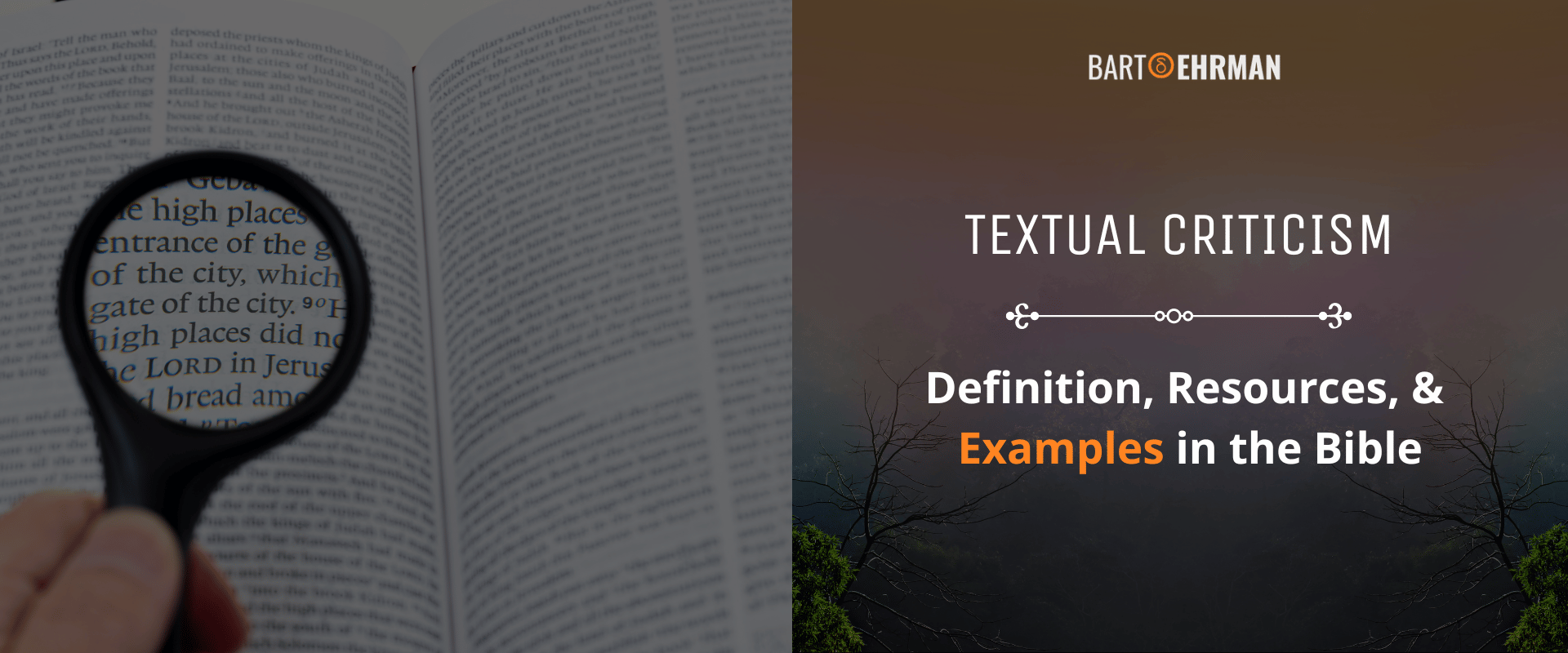Textual Criticism: Definition, Resources, & Examples in the Bible

Written by Joshua Schachterle, Ph.D
Author | Professor | Scholar
Author | Professor | BE Contributor
Verified! See our editorial guidelines
Verified! See our guidelines
Edited by Laura Robinson, Ph.D.
Date written: September 11th, 2024
Disclaimer: The views and opinions expressed in this article belong to the author and do not necessarily match my own. - Dr. Bart D. Ehrman
In the world of biblical studies and the study of ancient texts, textual criticism plays a crucial role in piecing together the past. This scholarly discipline is dedicated to determining the most accurate version of a text.
In this article, I’ll explain some of the core principles of textual criticism, explore various resources available for scholars, and present concrete examples of textual variants found within the Bible. By understanding the methods and challenges involved, we can get a clearer perspective on how textual critics uncover the closest possible representation of ancient writings and what that means for our understanding of historical texts.

What Is Textual Criticism?
Textual criticism is a vital part of the discipline of biblical studies as well as the study of ancient writings in general. When we don’t have an original, handwritten copy of an ancient writing (called an “autograph”), textual critics look at the various manuscripts of that writing, noting differences between them and trying to get at what the original probably said. As Bart Ehrman puts it, textual criticism “is the discipline that tries to establish what the original words were — or at least tries to decide which words to print if there are a variety of options.”
As is the case with many ancient documents, we don’t have a single autograph of any biblical text. What we have are manuscripts, which are copies of copies of copies, usually made years after the original was written and often differing in multiple ways. For a text such as the Bible, this presents a problem for those who believe it is inerrant: which version is free from error? For many, this question demonstrates that there is a lot at stake in the study of textual criticism.
Before the printing press was invented, people could only write and copy books by hand. This left a lot of room for copyist errors. In his book Misquoting Jesus: The Story Behind Who Changed the Bible and Why, Bart Ehrman notes that
(Affiliate Disclaimer: We may earn commissions on products you purchase through this page at no additional cost to you. Thank you for supporting our site!)
none of these copies is completely accurate, since the scribes who produced them inadvertently and/or intentionally changed them in places. All scribes did this. So rather than actually having the inspired words of the autographs (i.e. the originals) of the Bible, what we have are the error-ridden copies of the autographs.
For ancient writings such as those in the Bible for which we have no originals, textual critics examine the oldest manuscripts, noting differences — called “variants” — in the writing. In his book A Rationale of Textual Criticism, G. Thomas Tanselle writes that the job of the textual critic is to examine all the variants of a given text and remove those that are probably not original. The resulting text is called a critical text, the textual critics’ best estimate of what the original said.
Examples of Variants in Biblical Texts
Broadly speaking, textual variants can be put into two categories: unintentional changes and intentional changes. Ehrman notes that unintentional changes could occur simply because the scribe was “sloppy, or inattentive, or distracted, or sleepy, or ignorant” while intentional changes more often happened because “the scribe thought something was wrong in the text and so changed it, or didn’t like what it said and changed it, or thought he had a better way of putting it and changed it.”
Unintentional Variants
In A Student's Guide to Textual Criticism of the Bible: Its History, Methods and Results, Paul Wegner notes a number of examples of unintentional biblical variants. One type often found is a misreading, and thus miscopying, of individual letters, accidentally making a word not intended by the original author. For example, in some Greek manuscripts written in all capital letters (these are called “majuscule” or “uncial”), the Greek word ΟC (“who”) is misinterpreted as ΘC (“God”). This can be seen in some manuscripts of 1 Timothy 3:16, which says either “Who was revealed in flesh” or “God was revealed in flesh.”
Wegner further explains two other types of unintentional scribal errors called fusion and fission. Fusion is when two words which should be separated are read together. Conversely, fission occurs when two words should be joined together into one but are mistakenly separated. Both of these errors happened a lot in ancient times because scribes and/or copyists didn’t separate words on the page in ancient manuscripts. Imagine, for example, reading this:
GODISNOWHERE
One copyist would undoubtedly read this as “God is now here,” while another might read it as “God is nowhere.” Scribes had to make decisions about how to correctly read and interpret words like this all the time.
In the New Testament, there are many examples of fusion. One can be found in Mark 10:40. Textual critics have decided, based on manuscript evidence, that the original likely said this:
“…but to sit at my right hand or at my left is not mine to appoint, but it is for those for whom it has been prepared.”
The Greek words meaning “but for whom” are all’ hois but some manuscripts write it as allhois, one word which would mean “for others.” In the first example, Jesus merely admits that he doesn’t decide who will sit at his right and left hands. In the second, he tells the disciples it will be others, not them, who sit at his side. You can imagine that while some of these changes make very little difference to the overall meaning of a phrase, others can make a big difference.
We find an example of fission in some manuscripts of Romans 7. In some variants, the Greek word oidamen (“we know”) is split into oida men (“On the one hand I know”). The difference in meaning here is not that significant, but it is a difference which forces textual critics to decide which version is original to the text.
Intentional Variants
Sometimes, scribes deliberately changed something in a biblical text because they thought the text was incorrect in some way. This could mean fixing grammar or spelling, changing details to make a story more cohesive, or even making theological alterations so the text would fit with dogma. Let’s look at some examples of this.
In older manuscripts of Matthew 1:7-8, the name “Asaph” appears as one of Jesus’ ancestors. However, in a few later manuscripts, scribes changed the name to “Asa,” which was the name of a king of Judah found in 1 Kings 15. While it may be that the scribe was trying to insert more royalty into Jesus’ genealogy, it may also be that he was unfamiliar with the Hebrew name “Asaph” and thought he was correcting the spelling. Or both, since it’s often difficult to discern the intentions behind scribal changes.
In other cases, scribes appear to have changed or added words to clarify what they believed was the intended meaning of the text. An example of this can be found in Mark 1:2-3. The oldest manuscripts of this passage attribute a Hebrew Bible quote to “Isaiah the prophet”. However, the quotation is actually a composite of quotes from Malachi 3:1 and Isaiah 40:3. Apparently realizing this, later scribes attribute the quote more generally to “the prophets” in their manuscripts.
Additionally, sometimes scribes attempted to harmonize texts, changing them so that they agreed with other texts. In John 19:20, for example, it says that the inscription over Jesus’ head on the cross was written “in Hebrew, Latin, and Greek.” Luke’s Gospel doesn’t say anything about the languages in its oldest manuscripts, but some later copies add the phrase from John, with the languages in a different order, apparently to harmonize it with John’s Gospel account.
How Do Textual Critics Decide Which Variants Are the Originals?
In The Text of the New Testament: Its Transmission, Corruption, and Restoration, textual critic Bruce Metzger, one of Bart Ehrman’s main teachers in the field, outlines some of the criteria textual critics use to make key decisions about which manuscript evidence is likely original. Ehrman himself recommends this book for anyone interested in the field, beginners included.
Among many other things, the book includes a primer on some of the basic things a textual critic has to know to do this work, including the following:
- How were books made in antiquity?
- How were they published or made available for reading?
- What are the surviving manuscripts of the text in question?
- Into what ancient languages was the New Testament translated?
- How was the New Testament quoted by early Christian writers, and how do these quotations help us know what the original New Testament said?
- How was the New Testament changed by scribes over the centuries?
- What verses are most disputed among scholars today? And what is probably the “right” answer about how those verses were originally worded?
All of this knowledge helps text critics come to decisions on what was likely in the autograph of a given biblical text. The process might go like this: Let’s say we’re text critics working on the third chapter of the Gospel of John. The first step is to gather as many ancient manuscripts as possible — sometimes called “witnesses” — of John 3. Having done this, we scrutinize them to find any differences between manuscripts.
One of the first things to look for when understanding variants is external evidence. First, older manuscripts are preferred for obvious reasons: the older it is, the closer it was to the time the original was written so it may have fewer scribal errors. In addition, critics look in the margins of these manuscripts. If the scribe added alternative readings of a phrase or passage there, it likely means that he used more than one manuscript source for his copy. Knowing this, we could then look to see which manuscripts agree with the main and marginal texts.
Then we have internal evidence. Kurt and Barbara Aland outline some of this in their book The Text of the New Testament: An Introduction to the Critical Editions and to the Theory and Practice of Modern Textual Criticism. Two criteria they mention go by the Latin names lectio brevior (shorter reading) and lectio difficilior (more difficult reading).
Lectio brevior means scribes generally added words for clarification more often than they subtracted them. Therefore, the shorter reading is more likely to be original.
Lectio difficilior is the principle that scribes tended to try to harmonize texts to get rid of inconsistencies. This means the text that is unharmonized, meaning a bit more obscure and harder to understand in the context of the passage, is likely to be the original reading.
As you can imagine, there are many, many more criteria used by textual critics, so many, in fact, that it would be impossible to cover them all in this article. I’m sure you can see, though, that textual criticism requires meticulous attention to detail as well as an impressive amount of perseverance.

Conclusion
Textual criticism is the discipline in which scholars examine multiple manuscripts of biblical texts, attempting to reconstruct the original form of each one. This is important for the Bible since we don’t have a single original copy of texts from either the Hebrew Bible or the New Testament.
Manuscripts in ancient times were copied by hand, leaving them open to both intentional and unintentional errors. Sometimes, a scribe was just exhausted as he copied a text and thus made a mistake. Other times, the scribe attempted to help the text along, changing words or phrases to make them harmonize with other texts or with certain doctrines he found important.
The process by which textual critics decide which readings are the originals is difficult and painstaking. It involves looking at external evidence, such as the age of the manuscript and any scribal writing in the margins, and internal evidence, including the notion that shorter and more difficult readings are more likely to be original.
Despite the difficulties inherent in such an endeavor, Bart Ehrman notes that “there are good reasons for thinking that most of the time we can get back to a fair approximation of what ancient authors wrote.”
By the way, if you’re interested in learning more about textual criticism, check out Bart Ehrman’s online course “The Scribal Corruption of Scripture.”
FREE COURSE!
WHY I AM NOT A CHRISTIAN
Raw, honest, and enlightening. Bart's story of why he deconverted from the Christian faith.
Over 6,000 enrolled!

